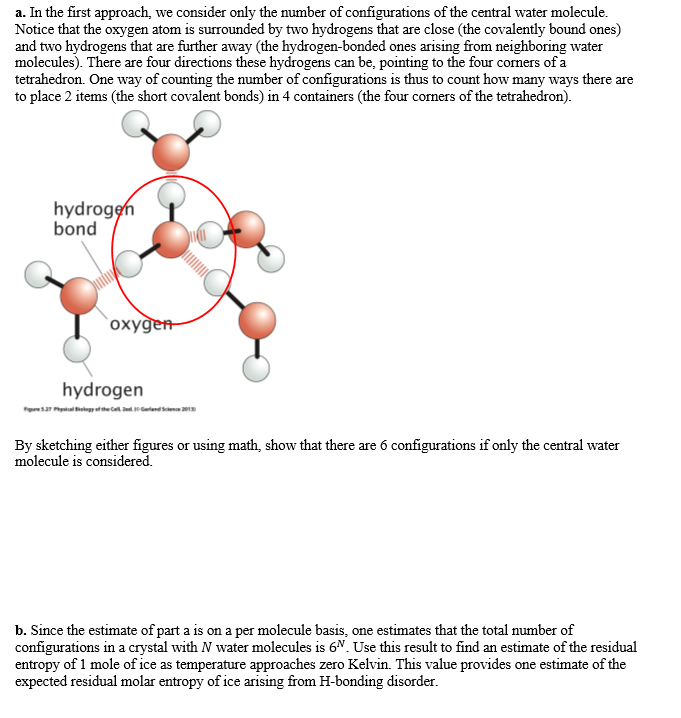a. In the first approach, we consider only the number of configurations of the central water molecule. Notice that the oxygen atom is surrounded by two hydrogens that are close (the covalently bound ones) and two hydrogens that are further away (the hydrogen-bonded ones arising from neighboring water molecules). There are four directions these hydrogens can be, pointing to the four corners of a tetrahedron. One way of counting the number of configurations is thus to count how many ways there are to place 2 items (the short covalent bonds) in 4 containers (the four corners of the tetrahedron). hydrogen bond охуден- hydrogen By sketching either figures or using math, show that there are 6 configurations if only the central water molecule is considered. b. Since the estimate of part a is on a per molecule basis, one estimates that the total number of configurations in a crystal with N water molecules is 6N. Use this result to find an estimate of the residual entropy of 1 mole of ice as temperature approaches zero Kelvin. This value provides one estimate of the expected residual molar entropy of ice arising from H-bonding disorder.
Basics in Organic Reactions Mechanisms
In organic chemistry, the mechanism of an organic reaction is defined as a complete step-by-step explanation of how a reaction of organic compounds happens. A completely detailed mechanism would relate the first structure of the reactants with the last structure of the products and would represent changes in structure and energy all through the reaction step.
Heterolytic Bond Breaking
Heterolytic bond breaking is also known as heterolysis or heterolytic fission or ionic fission. It is defined as breaking of a covalent bond between two different atoms in which one atom gains both of the shared pair of electrons. The atom that gains both electrons is more electronegative than the other atom in covalent bond. The energy needed for heterolytic fission is called as heterolytic bond dissociation energy.
Polar Aprotic Solvent
Solvents that are chemically polar in nature and are not capable of hydrogen bonding (implying that a hydrogen atom directly linked with an electronegative atom is not found) are referred to as polar aprotic solvents. Some commonly used polar aprotic solvents are acetone, DMF, acetonitrile, DMSO, etc.
Oxygen Nucleophiles
Oxygen being an electron rich species with a lone pair electron, can act as a good nucleophile. Typically, oxygen nucleophiles can be found in these compounds- water, hydroxides and alcohols.
Carbon Nucleophiles
We are aware that carbon belongs to group IV and hence does not possess any lone pair of electrons. Implying that neutral carbon is not a nucleophile then how is carbon going to be nucleophilic? The answer to this is that when a carbon atom is attached to a metal (can be seen in the case of organometallic compounds), the metal atom develops a partial positive charge and carbon develops a partial negative charge, hence making carbon nucleophilic.

Trending now
This is a popular solution!
Step by step
Solved in 3 steps


